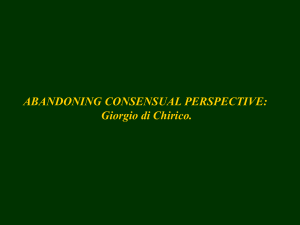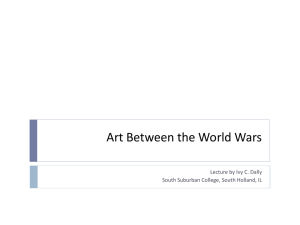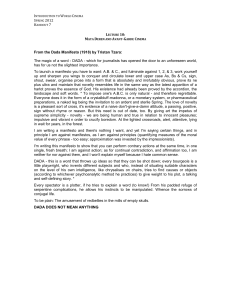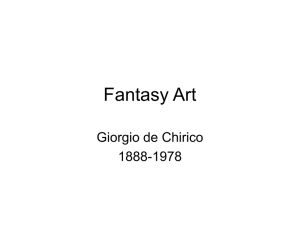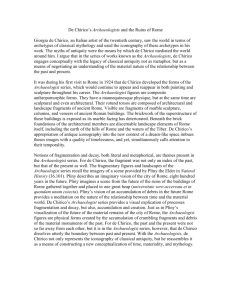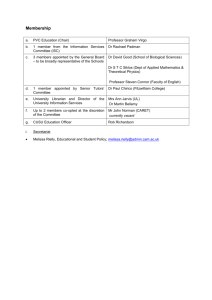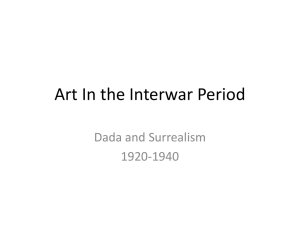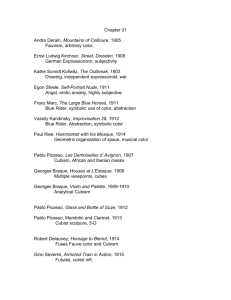Fantasy, the Metaphysical School and Dada
advertisement
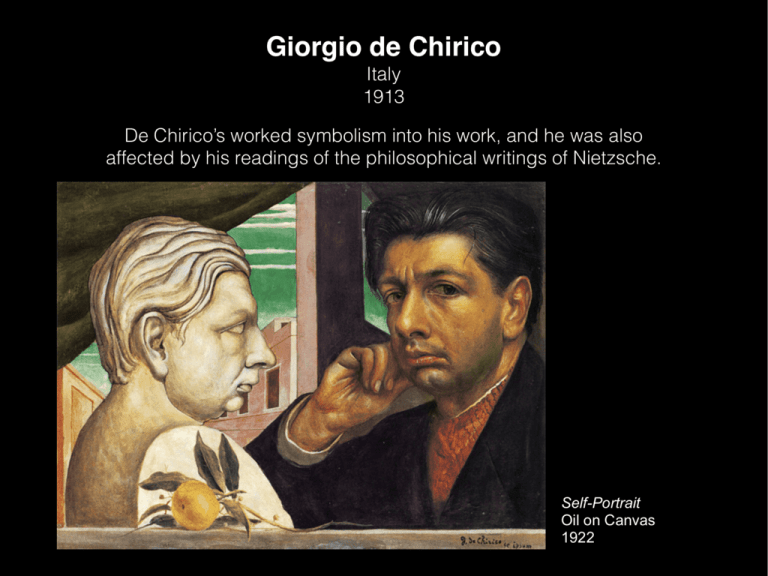
Giorgio de Chirico Italy 1913 De Chirico’s worked symbolism into his work, and he was also affected by his readings of the philosophical writings of Nietzsche. Self-Portrait Oil on Canvas 1922 Who is Friedrich Nietzsche? A metaphysical philosopher who’s work was related to the aspects of existentialism. Metaphysics— attempts to clarify the fundamental notions by which people understand the world leads to broad questions of the nature of causes, being and time. Existentialism — shared the belief that philosophical thinking begins with the human self— not merely the thinking subject, but the acting, feeling, living human individual Nietzsche himself proposed that each individual—not society or religion—is solely responsible for giving meaning to life and living it passionately and authentically. Waking Life by Richard Linklater https://vimeo.com/35992277 1:30:00 Nietzsche: “Art expresses deep-seated motivations within the human psyche” — led to de Chirico to his metaphysical examination of still life The melancholy of departure. Ariadne mourns her departed lover Theseus. Giorgio de Chirico The Soothsayer’s Response Oil on Canvas 1913 "I paint my own reality. The only thing I know is that I paint because I need to, and I paint whatever passes through my head without any other consideration." Giorgio de Chirico Love Song Oil on Canvas 1914 Metaphysical School Italy 1915-1920 “Truth pursued through the Dreamworld” Thanks to Freud and his studies on Psychoanalysis, the symbolism of dreams and the importance of instinct and emotion on human behavior, also served as inspiration of new modes of expression for artists. Metaphysical Painters retained the forms of Renaissance reality, perspective space, recognizable environment and sculpture figures and objects — assembling various juxtapositions to create an atmosphere of strangeness, fear and horror. Meanwhile, World War I had begun, and de Chirico and his brother were drafted into the Italian Army in 1915. De Chirico was stationed in Ferrara, but soon afterward, he had a nervous breakdown and spent time in a military hospital. In 1917, he met artist Carlo Carrà, who worked with him to define his style of "metaphysical painting," emphasizing the hidden significance of ordinary places and objects. The Metaphysical School sought after a elegiac and enigmatic expression that did not reject the art of the past. Classic and Modern, this was commonplace in Italian cities- a palazzo may become a 19th Century railway station. Giorgio de Chirico The Great Metaphysician Oil on Canvas 1917 Carlo published Pittura Metafisica in 1919 about the Metaphysical School. De Chirico felt like he was not given adequate credit, become embittered ended the friendship and the Metaphysical School. After World War I, (after 1920) de Chirico shifted in style and intention in his own work, and settled on academic classicism. He completely abandoned experimentation and attempted to rejoin the mainstream of European post-Renaissance Painting. Giorgio de Chirico Greetings of the Departing Argonauts Tempera on Canvas 1920 meanwhile an art movement…..hmm….more like a practice of art was emerging throughout Europe and into the United States… “…the sickest, most paralyzing and most destructive thing that has ever originated from the brain of man." -American Art News "a phenomenon bursting forth in the midst of the postwar economic and moral crisis, a savior, a monster, which would lay waste to everything in its path... [It was] a systematic work of destruction and demoralization... In the end it became nothing but an act of sacrilege." -Various Artists of the Movement “This was not art: it was “anti-art." It represented the opposite of everything which art stood for. Where art was concerned with traditional aesthetics, it ignored aesthetics. If art was to appeal to sensibilities, this was intended to offend. -Hans Richter, Artist Dada Zurich, New York, Berlin and Paris 1915-1924 Zurich Dada Cabaret Voltaire 1915 New York/American Dada Marcel Duchamp Bicycle Wheel Readymade 1916 Berlin/German Dada Hannah Höch Cut with the Dada Kitchen Knife through the Last Weimar Beer-Belly Cultural Epoch in Germany Collage 1919 Paris/French Dada Man Ray André Breton A Literary Movement Spurred Surrealism Dada was a response to the brutal, mechanized madness of war. An art movement, anti-war organization, the artists used abstraction to fight against the social, political, and cultural ideas of that time that they believed had caused the war. Many Dadaists believed that the 'reason' and 'logic' of bourgeois capitalist society had led people into war (cultural and intellectual conformity). They expressed their rejection of that ideology in artistic expression that appeared to reject logic and embrace chaos and irrationality. Dada 1915-1919 Zurich, Switzerland Switzerland managed to stay neutral (but armed and protected themselves) during WWI and WWII. Because of this neutrality, they became a safe haven for refugees. Zurich, Switzerland 1915 Lenin’s residence where he hung out with his Bolshevik friends…. Birthplace of Dada Two anti-war groups forming right next to each other "For us, art is not an end in itself ... but it is an opportunity for the true perception and criticism of the times we live in." -Hugo Ball Hugo Ball and nightclub entertainer Emmy Hennings founded Cabaret Voltaire in Zurich as a meeting place for free spirits who's art attacked the preconceptions of Western Art and Literature. (Because to Dadaists, were a part of how and why everyone went to war). Theatre activity evolved into performance art. Dada Performance was the important precursor to the sixties “happenings” and Fluxus group (after WWII) Emmy Hennings on stage as “truthspeaking” spider with Marcel Janco 1915 Hugo Ball Introduced abstract poetry in 1916, wrapped in a cardboard costume, he recited he “sound poem”, Karawane. Ball’s thesis, that conventional language had no more in place in poetry than the outworn human image in paintingproduced a chant of more or less melodic syllables without meaning. “zimzim uralla zimzim zanzibar zimlalla zam”. This experiment affected the subsequent course of 20th century poetry. Ball reciting the poem Karawane at Cabaret Voltaire, Zurich Photograph of Performance 1916
